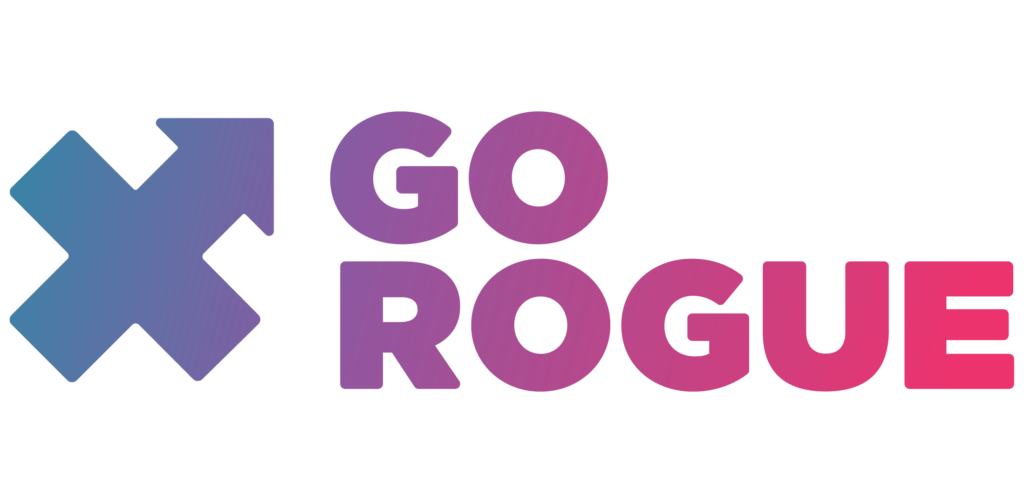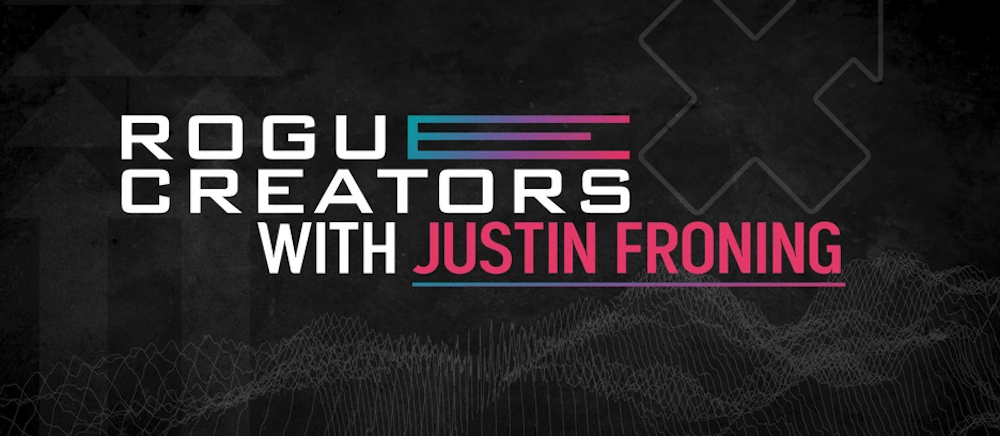Welcome to the Rogue Creators Video Series, a limited series featuring various artists that inspire the Go Rogue team. Throughout the episodes, which release bi-weekly, Bryan Fittin and Loren Lewis sit down with five of our team’s favorite artists to discuss their work, what inspires them, and how they stay creative.
Join us every other Friday from now through July 8th.
Justin Froning, a longtime friend of the Go Rogue team, recently stopped by the studio to talk with Bryan Fittin about his career in design and illustration and provide some backstory for some of his favorite work. Justin is the founder and operator of Housebear Design and is a designer, illustrator, and musician who has a passion for storytelling and iconography.
Justin was passionate about drawing at a young age, but as his friends took up new hobbies in music, he decided to follow their lead. His passion for visual art continued with him as he established himself in the music scene with his band Deas Vail. As the band became more successful and began touring regularly, Justin kept himself busy on long drives by designing merch, posters, album artwork, and more for the bands he met along the way.
While living in Seattle, Justin found inspiration and mentorship from his roommate, an old friend from the music industry who now had a corporate job in graphic design. He came alongside Justin and encouraged him to share his portfolio and continue to develop his design skills.
Kevin Tong, another one of Justin’s significant influences, designed a concert poster for a show Deas Vail was playing with Copeland, and his illustrative style inspired Justin to begin drawing again. While he had already established a design style of his own, Justin started incorporating illustration, creating the unique and easily recognizable style he is known for today.

Justin met and worked with countless bands on the road, but working with Wilco came as a pinch-me moment. He had joined a poster design class that DKNG was leading through Skillshare, and that’s when he came up with the idea for a songbird casting the shadow of an owl. He loved the existential nature of the illustration, which revealed a serious and intimidating force alive within this beautiful songbird.

The songbird and owl design was Justin’s first time receiving honest feedback from industry professionals, and the positive reactions encouraged him to share the poster with Wilco’s management. The band loved it, and thus a class project became a reality.
Justin’s second design for Wilco was the stag poster, which he designed and illustrated while still living in Seattle. The original colors were orange, purple, and blue, but the band suggested he change them to the earth tones present in the final version of the poster.

When Justin designed the flamingo poster, he originally intended it to go to The Get Up Kids, but when he didn’t hear back from their management for a time, he sold the design to Wilco. Shortly after the design was sent to the printers, The Get Up Kids reached out about using the design as the poster for an upcoming tour. Luckily, Justin was able to talk with the band and offer several alternative options, leading to a long-term partnership with his favorite band.

Before the Covid pandemic, Justin worked mostly with concert posters and other art related to the music industry. But in the spring of 2020, he knew he’d need to branch out, as the music industry was mainly shut down at the beginning of the pandemic.

He had always loved alternative movie posters and pop culture posters, so he decided to try his hand at designing his own. He realized a love for iconography—using icons to tell a story rather than using the characters—and more than anything else, he wanted to work on projects that had never been done before. Moreover, he’s used that as a bit of an informal motto while working on movie posters, saying, “If it’s been done well, I want to at least do it differently.”
At the end of 2020, Gallery1988 put out a call for artists, and Justin submitted his portfolio with little hope that he would hear back. A few months later, the gallery asked Justin to be part of several of their shows throughout the upcoming year.
The first show of the year was called 30 Years Later and played tribute to several classic movies from 1991. Justin chose to make alternate movie posters for The Rocketeer and Thelma and Louise, utilizing what he calls “detailed minimalism,” a style that has become synonymous with his work. He describes the technique as using a lot of detail in certain areas but keeping the overall composition very simple.
His poster for The Rocketeer might be the best example of the detailed minimalism style, with its complex rocket elements serving as the background for the design.

After working with Gallery1988, Justin worked with Hero Complex Gallery for his second pop culture submission. The gallery had five shows in mind for him, one of which was a John Hughes tribute show. He immediately knew that he wanted to do Ferris Bueller’s Day Off and use Cameron’s dad’s car as the centerpiece.
He saw the background as an opportunity for easter eggs, so he drew a cartoon map of their adventures to frame the featured car illustration. On the car itself, Justin replaced the hood ornament and grill piece—which would typically be a Ferrari stallion—with Ferris singing in the parade.

Hero Complex Gallery loved Justin’s poster for Ferris Bueller’s Day Off so much that they offered him a solo show that would feature several more pieces in the same vein. For the gallery—known as Driven: The Iconic Cars that Drive Us—he designed and illustrated posters featuring Spinner from Blade Runner, the Catbus from My Neighbor Totoro, the Wagon Queen Family Truckster from Vacation, the Interceptor from Mad Max, and Nedry’s Jeep from Jurassic Park.

Shortly after finishing Driven: The Iconic Cars that Drive Us, Justin reached out to Moor-Art Gallery about potentially working together. As it turns out, he was already on their radar, and they asked him if he would be interested in creating posters officially licensed by Hasbro for the original The Transformers.
Without a doubt, this was one of the most surreal moments of Justin’s career. He was a massive fan of The Transformers as a child, and printing an officially licensed poster was a dream come true.
He decided to feature Soundwave because he loved how it transformed into the always-nostalgic cassette tape player. While this design is slightly less simplistic than Justin’s other work, he stuck with another of his staples: a limited color palette.
When he began working with bands at the beginning of his design career, he learned to work with as few colors as possible to keep prices low. It has become one of the most recognizable characteristics of his work, and he continued the trend with these two three-color prints.
He chose two make two editions, allowing him to expand his color palette slightly. The Buzzsaw (yellow) and Laserbeak (red) editions feature the two bird-like Transformers often seen with Soundwave.
Connect with Justin
Looking back on the start of his career, Justin has become passionate about connecting with other artists and helping new designers and illustrators find their footing. To connect with Justin and follow his work, check out his website and Instagram.


